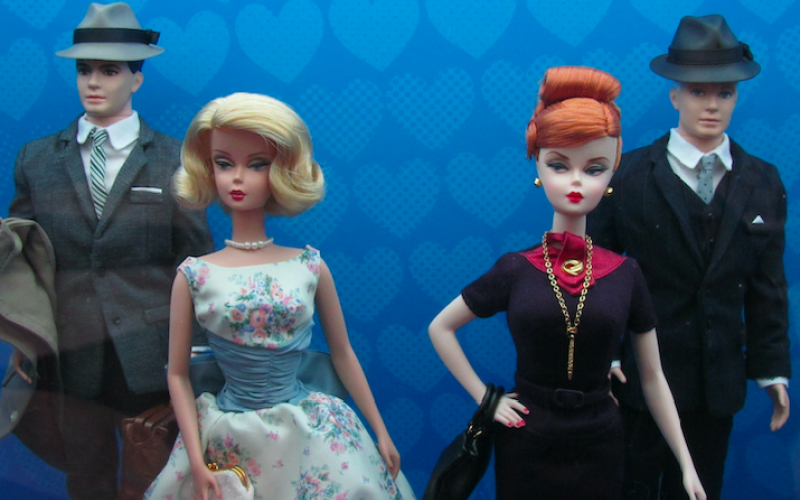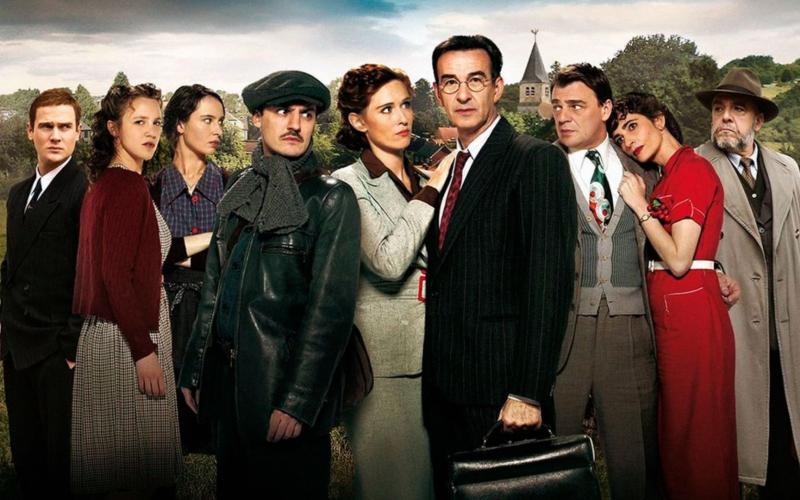By using a 60s workplace as its setting, Matthew Weiner’s Mad Men (2007-2015) does not merely provide insight into historical gender and sex relations in the workplace of the 60s. It also reflects current sex and gender relations in the workplace of 21st century America (e.g. the #MeToo Movement). As Sara Rogers, leaning on Horace Newcomb and Paul Hirsch, argues, tv shows’ strength lies in their raising questions, rather than answering them.[1] This is precisely what Mad Men, with its representation of 1960s sex and gender dynamics does. In the following blogpost I will show that Weiner’s hit show is very aware of – among others – Helen Gurley Brown’s influence on the American workplace of the 60s and that it uses its nostalgic effect for reflecting contemporary sex and gender relations in the workplace.
Mad Women in Advertising
It is often claimed that Mad Men provides a historically accurate depiction of a 1960s ad agency.[2] Although working women – especially married working women – were not often seen in a working environment. In fact, women often were forced out of their jobs after marriage, or when they got pregnant, the latest, as Jane Maas, former ad woman and author of Mad Women (2012) explains. The advertising business has had women working as copywriters ever since advertising became a business.[3] More than being occasionally assigned to copywriting tasks, women were a constant part of the workforce. Advertising seems to have been an attractive business for women, where they stood the chance of having a real career. There they were not solely responsible for copywriting jobs, but also “[…] managed corporate advertising activities, ran publicity campaigns, and coordinated fashion shows,” writes Juliann Sivulka in her book Ad Women (2009). Career women, i.e. middle class women who worked not as a necessity, but as a choice, became a rarity after WWII. In fact, and as Betty Friedan states in The Feminine Mystique (1963), during the post-war years women vanished from the workforce. After years of contributing to the GOP and the warfare, out of necessity and patriotism, by manufacturing missiles and stepping in into typically male-dominated industries, the most patriotic thing for women to do was serving dinner to the returned shell-shocked soldiers and providing them with a safe home.
When women then were interested in careers outside the home, which increasingly happened during the 60s – those were, after all, the times that fueled feminism and that saw a rise in divorces[4] – their male coworkers and bosses met them with suspicion and saw them as a threat. One of those women was Helen Gurley Brown, writer of Sex and the Single Girl (1962) and Sex and the Office (1964). She was a copywriter in an ad agency during the 60s. In her books, which were highly influential in their times, she provides advice for career women, which is closely tied to how women should behave towards their male coworkers. Her books became so successful that, after losing her job as a copywriter, Gurley Brown landed a job as editor-in-chief at Cosmopolitan, shaping what we would come to know as postfeminism.
The Mad Man’s Power
Many things Gurley Brown describes from her own, and her friends’ and colleagues’ experiences are echoed in Mad Men. One should not forget, however, that it is merely a 00s view on the decade, and as such, it is a reflection of the present, more than it is an adequate or precise depiction of the past. In fact, Jane Maas, a real-life Mad Woman, constantly points at things Mad Men does not get right. Before Joan becomes a mother, for instance, the series is missing working women with children entirely. Were there only childless women working at Sterling Cooper, one might ask, if even Gurley Brown writes about her working girlfriends with families. Sometimes, those discrepancies, like Freudian slips, remind us of the series not being like Borge’s precise 1:1 map of the 60s, but merely a simplified version thereof, that fulfills its own purpose; namely the transfer of contemporary issues. In the following I will provide a few examples, where such a reflection is noticeable.
When it comes to the workplace, Mad Men is centered around Peggy’s (and later also Joan’s) career, more than it is around Don’s, I would argue. Don’s career is part of the plot, but almost only in relation to Peggy (there is also a “rags to riches” storyline going on, which I will ignore for the purpose of my argument). This mirrors the most general rule, the series constantly reflects upon, which is that women have to maintain good relations with men, if they want to succeed at their jobs, as Mimi White observes.[5] Peggy Olson’s career is dependent on her boss getting along with her. When Peggy suggests that using a skinny model for a diet cola is not a good strategy, Don does not listen to her critique, since he thinks he knows best what women want.[6] Men are the decision-makers in the agency, after all. The ad, however, becomes a flop, and Peggy, in the end, seems to be right. Women’s inferiority in the workplace becomes also evident throughout the series whenever Peggy asks for decent workspaces and equal pay but reaches its climax when Joan is asked to sleep with an affiliate so that the agency can seal the deal with Jaguar, and she becomes a partner in exchange – still, she is not taken seriously, which makes her position as a partner rather symbolic.[7] What becomes evident is that throughout the series, the male characters’ storylines focus on their sexual relationships mainly, while their careers – which are almost a given – are mainly happening in the background. The women’s storylines, however, mainly focus on their careers, and their sexual relations are overall secondary or a means to an end, juxtaposing postfeminist plotlines, we know from series, such as Sex and the City (1999-2004), Jane the Virgin (2014-2019), and many more. We can see this on the example of Peggy. While in the beginning, there is strong emphasis on Peggy’s sexuality, this gradually declines parallel to her career rising.
While Peggy does the opposite of what men and women of the office expect from her, Joan does what Gurley Brown suggests to women who want to succeed; namely that they should “[c]ontinue to charm. Though a certain executive can’t stand you, this is no reason for you not to continue to be cheerful and adorable.” And “[w]ear your most beautiful clothes. Get your hair done often. Smell glorious.”[8] After all, “[y]ou’re in a man’s world […].”[9] Gurley Brown makes clear that there is a certain way women must behave to be accepted at their workplace. Women must be “easy to talk to” and pretty.[10] And this is echoed in the advice Joan gives Peggy in the very first episode. She tells her what to wear, and, famously, to cut holes into a paper bag, get undressed and look at herself in the mirror.[11]
To be taken seriously in the workplace, thus, women are also required to work harder than men. Mad Men characters are modeled after stereotypes, one might, for instance, know from publications, such as, Rosabeth Moss Kanter’s Men and Women of the Corporation (1977). Gurley Brown also describes a number of female stereotypes at the office, such as the childlike girl, the pretty ex-farm girl, the femme fatale, or the lady tycoon.[12] Accordingly, Joan and Peggy are reduced to stereotypes, as Sara Rogers argues; “[…] the hyper-sexualized secretary and the female nerd […].”[13] Joan struggles with men’s weakness of not being able to respect her intelligence, competence and (sexual) power.[14] Her power, however, is dependent on patriarchal structures and the male gaze.[15] Peggy, on the other hand, struggles with being a woman by trying to make it in ‘a man’s world’. Her way of dressing and her behavior towards men makes her seem less feminine and therewith less of a woman to her male co-workers. Most of the time she refuses to stick to the rules Gurley Brown formulated and I briefly mentioned above, and that are still existent in the workplace – otherwise Taylor Swift would not have written a song about it (“[…] What I was wearing / If I was rude / Could all be separated from my good ideas and power moves?”, ‘The Man’ 2019). Her refusal, however, is taken as failure, which takes away her agency and raises the question whether a career woman is still perceived and seen as a woman.[16] If a woman has to decide whether she is a Jackie or a Marilyn[17] - which is something women asked themselves still upon the episode’s airing when blogs offered quizzes providing the answer to this question,[18] and which is also still a reference in pop culture[19] - where does a woman like Peggy position herself? Most of all, however, this shows how rooted those stereotypes still are in 21st century America. And this might also have to do with women applying to stereotypes, as the child-like girl, like Jane, who came running to Roger, crying, after Joan fired her.[20] This results not only in her getting back her job, but even marrying her boss.
Although women having careers is not uncommon or outlandish anymore, women still often are expected to find a husband and to have children. They are expected to ‘have it all,’ as Gurley Brown suggests. The ideal of ‘having it all’ is part of Gurley Brown’s view on work as early as 1964, when she writes in Sex and the Office: “Don’t you see that by working you could have it all?”[21] But it was her book Having It All: Love, Success, Sex, Money . . . Even if You’re Starting With Nothing (1982) together with her contributions to Cosmopolitan, that manifested the having-it-all-lifestyle as a postfeminist ideal and brought about series such as Sex and the City. Post-feminism believes that the goals of feminism have been achieved already and, thereby, produces what author and BuzzFeed News columnist Anne Helen Petersen, in her book Too Fat, Too Slutty, Too Loud (2017), calls “the lifestyle supermom”:
“By transforming themselves into brands, filling their online stores with goods and clothing and accessories, they imply that every woman can have the same sort of contentment: all they need to do is buy a dress, purchase some chemical-free baby wipes, and follow a complicated recipe for a vegan smoothie, and they can have the same bronzed glow of contentment as these celebs.”[22]
This idea of an achievability of love, success, sex, and money is reproduced in tv series, ever since. Sex and the City, for one, and as Erika Engstrom observes, reproduces patriarchal structures, since the four women tend to constantly talk about men.[23] Series, such as The Good Wife (2009-2016), on the other hand, take women’s careers for granted, and therefore reproduce the postfeminist idea of women not only being able to ‘have it all’[24] but that having it all comes easy to them.
Mad Men, by solely depicting women in the offices of 1960 America – with the lack of options, and sexual harassment most likely to await them – makes the audience see, that not much has changed. Looking at the industry Mad Men is produced in, for instance, one cannot help but see women’s inferiority and vulnerability in the workplace. The #MeToo-Movement, triggered by the unraveling of Hollywood’s producer Harvey Weinstein’s decades-long sexual harassment and abuse of women in the film industry, shows that, despite postfeminism’s belief in having achieved feminism’s goals, we are not done with feminism. In fact, “it is still very much necessary.”[25] Petersen sums up the scandal as follows:
“Hollywood, after all, condenses and reflects society’s larger, and often ugly, ideological tendencies: the supremacy of whiteness, the capitalist ethos, the presumption of heterosexuality, the invisibility of women who aren’t hot or thin or under the age of forty-two. Hollywood fancies itself one of the most progressive places in the world, even as it reveals itself – as both an industry and a producer of art – to be one of the most regressive and conservative. The details of Weinstein’s behavior, and the sheer number of actors, agents, producers, publicists, assistants, and gossip columnists who were complicit in its perpetuation, underline just how little has changed since the days of classic Hollywood. Women are still paid less in Hollywood. Women have far fewer chances to produce and direct. Women have less power. Put bluntly, Hollywood – like society – values women less than men.”[26]
Weinstein was a scandal. But it was not a new behavioral pattern in the industry or the workplace in general. In 2009, David Letterman admitted to having had sex with his female employees.[27] In other industries, similar patterns of power dynamics can be traced, such as at Goldman and Sachs, who in 2010 were accused of gender bias[28] and allegedly tried to cover up sexual harassment,[29] and the online personal finance company SoFi’s sex scandal from 2017.[30] The overall workplace – with a few female-dominated workplaces being an exception –, therefore, is still very much male-dominated. Women have to fight for their place therein, which is very much dependent on men.
Even after they found their place in the workplace, the women’s workforce is still not valued. Their achievements are still belittled, even though “[…] women hardly ever get responsible jobs without having talent and working hard […],” as Gurley Brown states.[31] When Joan experiences sexual harassment in the office, by being objectified in a pornographic cartoon, she gets angry at Peggy for complaining about it to Don.[32] She rather accepts sexual harassment – and being violated, as Lucht and Marcellus argue –, than being belittled by a complaint that makes her seem meaningless and Peggy seem difficult,[33] echoing prevailing female fears.
What Mad Men constantly shows, is how naturally men exert their power and degrade their female co-workers or employees to sex objects and/or the other woman. For Roger, Joan is the other woman he claims to love, but does not leave his wife for (later in the series he starts an affair with the much younger secretary Jane who he leaves his wife for and gets married to). Peggy also becomes the other woman for a night, when Pete Campbell comes to her apartment for a booty call at the end of the first episode. She does not have much of a choice, as Tracy Lucht and Jane Marcellus argue, since she knows that her career is dependent on her boss and her male co-workers.[34] After all, Pete is in a more powerful position at the office. Refusing sexual relations, therefore, might cause the ending of her employment, and if it is true what Gurley Brown states, “[c]ompanies are not usually destroyed by sex.”[35] However, “[w]hen an affair is over, it usually isn’t possible to continue to work in the same office. It will be you who must get the new job, too. That’s protocol.”[36] One cannot deny certain power dynamics, even if “[a] girl can say no,”[37] if the ‘girl’ knows that she has to leave the office when the affair comes to its end. Jane Maas describes similar power structures in her book: “The term ‘sexual harassment’ hadn’t been invented yet, or certainly wasn’t in our vocabularies. Most women then working in advertising were either secretaries or copywriters, and 99 percent of us had male bosses. The boss was in control of your salary, your raise, your career advancement … your life. If he wanted to go to bed with you, you had to ask yourself what mattered more: your self-respect or your career.”[38] The power hierarchies between female workers and their male co-workers, who are, most of the time, their bosses, are still significant and should not be dismissed, today.
In 1998, for instance, Monica Lewinsky, intern at the White House at that time, was caught in an affair with her boss, then-president of the United States, Bill Clinton. Clinton had to face a possible impeachment, while Lewinsky was demonized by the media. Maybe this is the aftermath of books, like Gurley Brown’s, suggesting “[a] girl may not feel too guilty about charming a married man, because if she works for him, she can’t help observing what a spoiled, demanding creature his wife is.”[39] Maybe this is also the result of postfeminism, where an unrealistic picture of women and women’s lives gives the average woman the impression that she cannot do anything right. After all, Bill’s wife Hillary, still had to face criticism for her husband’s adultery during her campaign for the 2016 presidential election, when Donald Trump doubted her eligibility for the position since she even “[…] couldn’t satisfy her husband […].”[40] The scandal’s relevance, however, is proven by the currently running third season of American Crime Story (2016-), which is co-produced by Lewinsky herself and tells the story of the affair.
Conclusion
Rather than making us glamourize historically authentic misogyny, as Tonya Krouse believes to be the appeal of the series,[41] Mad Men makes us realize that we did not get far enough in the fight against sexual harassment and for equality for women in the workplace. Scandals at Goldman and Sachs, of David Letterman, Bill Cosby, Kevin Spacey, and Harvey Weinstein, just to mention a few, show that the workplace is still a gendered space, where power dynamics are still affecting its environment, and female workers are frequently violated. Maybe the series does this rather unconsciously, such as sexual harassment oftentimes happens unconsciously, and as Matthew Weiner supposedly did not realize his own harassing of a female writer.[42] This, however, is even worse, since it shows how ingrained those uneven power dynamics are.
Overall, women are still in inferior positions at the workplace; whether it is an office, a film set, or any other kind of workplace. Although women make out about half of the American workforce, they are still underrepresented in leadership positions.[43] Still, there is a gender gap in promotions and wages.[44] Women, therefore, are most likely to work for men, while earning less money for the same work their male colleagues do. While, in the 60s for most middle-class women working and having careers increasingly became a choice and getting married and starting families was still seen as an ideal, in 21st century America, working women are the norm. Getting married and starting families is not an alternative career anymore. This makes women even more vulnerable in the workplace, which is still dominated by men, and where women still are often seen as less valuable.
A final recent example from the culture industry, proves once again that, despite all the efforts of the #MeToo-Movement and Women’s Marches, little has changed. Britney Spears’ mental breakdown in 2007 is the result of the exploitation of a woman’s working power by white men, as Lena Dunham argues in her Instagram post ‘Forever our girl (Britney in 3 parts)’ from June 24, 2021.[45] Therein she states that women always have to be cautious about how they are perceived by society and their colleagues. They always have to make sure to fit their imposed standards not to be perceived as difficult to work with. It is, therefore, not surprising if women feel like they are “both too much and not enough every day” as Dunham explains. Mad Men, by depicting a typical office from the 60s brings the power dynamics of men and women in the office ad absurdum, just to show that they are not absurd at all. The same fights women were fighting then, they are still fighting now.
[1] Rogers, Sara. ‘Mad Men/Mad Women: Autonomous Images of Women’. In: Stoddart, Scott F. Analyzing Mad Men: Critical Essays on the Series. Jefferson: McFarland, 2011, 156.
[2] See, for instance, Rogers, ‘Mad Men/Mad Women’, 156 and Krouse, Tonya. ‘Every Woman is a Jackie or a Marilyn: The Problematics of Nostalgia’, In: Stoddart, Scott F. Analyzing Mad Men: Critical Essays on the Series. Jefferson: McFarland, 2011, 195.
[3] Cracknell, Andrew. The Real Mad Men: The Renegades of Madison Avenue and the Golden Age of Advertising. Philadelphia/London: Running Press, 2011, 196.
[4] See the 1960s census.
[5] Edgerton, Gary R. Mad Men: Dream Come True TV. London/New York: I.B. Tauris, 2011, 148.
[6] ‘Love Among the Ruins’ 03x02.
[7] ‘The Other Woman’ 05x11.
[8] Gurley Brown, Helen. Sex and the Office. Fort Lee: Barricade, 1964, 89.
[9] Gurley Brown, Sex and the Office, 223.
[10] Gurley Brown, Sex and the Office, 223.
[11] ‘Smoke Gets in Your Eyes’ 01x01.
[12] Gurley Brown, Sex and the Office, 307.
[13] Rogers, ‘Mad Men/Mad Women’, 155.
[14] Rogers, ‘Mad Men/Mad Women’, 156.
[15] Krouse, ‘The Problematics of Nostalgia’, 193.
[16] Krouse, ‘The Problematics of Nostalgia’, 194.
[17] ‘Maidenform’ 02x06.
[18] Krouse, ‘The Problematics of Nostalgia’, 197.
[19] see, for instance, Gossip Girl ‘The Debarted’, 03x12.
[20] ‘The Gold Violin’, 02x07.
[21] Gurley Brown, Sex and the Office, 262.
[22] Petersen, Anne Helen. Too Fat, Too Slutty, Too Loud: The Rise and Reign of the Unruly Woman. New York: Penguin, 2017, xviii.
[23] Engstrom, Erika, Tracy Lucht, Jane Marcellus & Kimberly Wilmot Voss. Mad Men and Working Women: Feminist Perspectives on Historical Power, Resistance, and Otherness. New York: Peter Lang, 2016, 4.
[24] Engstrom, Mad Men and Working Women, 5.
[25] Petersen, Too Fat, Too Slutty, Too Loud, xvi.
[26] Petersen, Too Fat, Too Slutty, Too Loud, xv.
[27] Carter, Bill & Brian Stelter. ‘Letterman Extorsion Raises Questions for CBS’, New York Times, Oct 2, 2009.
[28] Lattman, Peter. ‘3 Women Claim Bias at Goldman’, New York Times, Sept 15, 2010.
[29] Sonnemaker, Tyler. ‘Goldman Sachs tried to cover up sexual misconduct by one of its top lawyers, according to a lawsuit from a former employee who says she was fired for speaking out’, Business Insider, Oct 27, 2020.
[30] Popper, Nathaniel & Katie Benner. ‘‘It Was a Frat House’: Inside the Sex Scandal That Toppled SoFi’s C.E.O.’, New York Times, Sept 12, 2017.
[31] Gurley Brown, Sex and the Office, 83.
[32] The Summer Man’ 04x08.
[33] McNally, Marcellus, Forde & Fairclough. The Legacy of Mad Men, 120.
[34] McNally, Karen, Jane Marcellus, Teresa Forde & Kristy Fairclough. The Legacy of Mad Men: Cultural History, Intermediality and American Television. Cham: Palgrave Macmillan, 2019, 119.
[35] Gurley Brown, Sex and the Office, 186.
[36] Gurley Brown, Sex and the Office, 239.
[37] Gurley Brown, Sex and the Office, 194.
[38] Maas, Jane. Mad Women: The Other Side of Life on Madison Avenue in the ‘60s and Beyond. London: Bantam Press, 2012, 29.
[39] Gurley Brown, Sex and the Office, 200.
[40] Petersen, Too Fat, Too Slutty, Too Loud, 156.
[41] Krouse, ‘The Problematics of Nostalgia’, 202.
[42] Buchanan, Kyle. ‘Matthew Weiner on Life After ‘Mad Men,’ Sexual Harassment and His New Amazon Show’ New York Times, October 3, 2018.
[43] Warner, Judith, Nora Ellmann & Diana Boesch. ‘The Women’s Leadership Gap’. Center for American Progress, November 20, 2018.
[44] Bleiweis, Robin. ‘Quick Facts About the Gender Wage Gap’. Center for American Progress, March 24, 2020.
[45] Lena Dunham’s Instagram Profile, June 24, 2021.
Zitation
Maria Wiegel , MAD MEN AND WOMEN IN THE OFFICE. Sex and gender in the workplace , in: Zeitgeschichte-online, , URL: https://zeitgeschichte-online.de/film/mad-men-and-women-office











